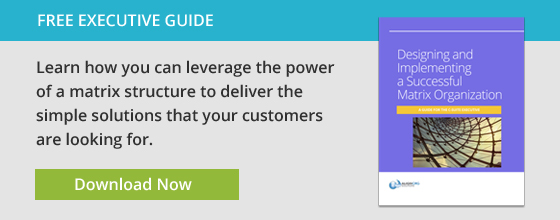How do the people in your organization approach major decisions? Do they rely on gut instinct? Do they ask superiors, coworkers, or customers? Or do they turn to analytics for insights that can help them make the best choice based on real-world outcomes?
Many organizations spend millions of dollars collecting, organizing, and distributing data. All too often, that data sits unused, because the people who need it either (1) can’t access it, (2) can’t understand it, or (3) don’t know exactly what to do with it.
Over the past two weeks, we’ve been exploring aspects of building a corporate culture that aligns with your strategic objectives (you can read the posts here and here). The same strategies that allow us to build strong cultures also enable us to build capabilities, like using analytics to foster more strategically aligned decision making across the organization.
Cultivating the strategic use of data-driven insights goes beyond having a team of “smart guys” who can crunch the numbers. Yes, we need our data scientists, but until the use of analytics becomes ingrained in the workflows of your organization, all that data will never reach its full potential as a strategic asset.
Let’s look at some of the obstacles that prevent your valuable data from empowering your decision makers — and how to overcome those hurdles.
Obstacle #1: Lack of Purpose
Many organizations collect mountains of analytics because they know it’s a good thing to do, but stop short of clarifying why they do it. Data is not an end in itself. It’s a tool that can serve many different objectives, and without a clear purpose behind their data, organizations will never use it to its full potential.
For example, an organization may collect data on lost customers and explore ways to reduce those numbers. They can feel good about the fact that they’re addressing the attrition problem, but they’re missing bigger questions such as “what do customers want from us?” and “why do customers choose us in the first place?” Then the data becomes part of a bigger picture that promises a greater reward than simply losing fewer customers.
Solution: Begin with your organizational strategy, then determine how analytics can contribute to the achievement of your goals. For example, one client recently set up up a small innovation lab to help them measure the performance of their end-to-end supply chain. Being able to see how the complete supply chain was performing gave leaders tremendous insights into how to better allocate capital, make process improvements, and most importantly, differentiate their organization from competitors. The innovation lab was a great success, but the power in the insights it revealed came from asking the right strategic questions.
Obstacle #2: Lack of Breadth and/or Depth
For analytics efforts to serve the organization well, those performing the analyses must be able to simultaneously look across the organization (broad) and deep into key areas of the organization. Having a data scientist locked in a closet won’t provide the types of analyses that organizations need — rather, those analyzing the organization’s data must be able to look across and deep at the same time. The key is finding the people or the means required to bring together both business context and functional expertise to ask the right questions to uncover the insights that will truly lead to breakthroughs.
Solution: Structure and manage your team of data experts in a way that places their expertise at the service of those who need it across the organization. I have seen some organizations build robust data and analytics teams with strong expertise, but they are completely disconnected from business realities. By lacking business understanding and context, their brilliance is lost on the esoteric analyses they are able to conduct, contrasted with the timely, intuitive insights that are possible by combining those with business experience and context with those who are analytics experts.
Obstacle #3: Technology Shortfalls
Sometimes the biggest problem is the data itself: analytics functions may depend on legacy systems, repositories, and other data sources that may not be easily accessible or easily mined. Any analytics capability built on this kind of foundation is a house of cards.
Solution: While there is no easy answer to technological or legacy data issues, the key is finding ways to update legacy systems and scrub data as necessary to provide the foundation needed to deliver on organizational needs. This topic alone requires a separate discussion, but there are innovative ways of pulling data from legacy systems and sources, and of working with them in dynamic environments that can allow for the types of analyses that will help the business move forward.
Obstacle #4: Lack of Expertise in Data-Driven Decision Making
Even if the organization can overcome the previous obstacles, benefits can be muted if managers and leaders don’t know how to use data and analytical insights to make better decisions. Leaders may have been making decisions based on gut instinct or historical experience for decades because that’s the only way they knew how. Many organizations distribute quality data reports or make dynamic reporting suites available on a regular or real-time basis, only to have them go unused because no one’s sure what to do with them.
Solution: Teach your managers how to assess their data reports and incorporate data-driven insights into their decision-making processes. We have seen some organizations hold periodic decision acceleration sessions where leaders are assembled in an intense work session. The session is preceded by the identification of key strategic questions, the pulling of relevant data, and the modeling of possible scenarios. When the decision acceleration session is held, leaders walk through the scenarios vis-à-vis the strategic questions and discuss business implications. The best sessions end with a decision to move forward, to not move forward, or to gather additional information from which a decision can be made shortly thereafter. These sessions not only accelerate decision making, but also help leaders learn how to use data and insights to inform their decision-making processes.
From Information to Insights
Organizations around the world are using analytics brilliantly in advancing towards their goals, and not because they’re simply sharing information. The ones who build successful analytics capabilities are focused and purposeful in their attitude towards their data. They’ve set objectives, determined how data will help them achieve what they set out to do, and empowered their decision makers to use the insights available to them. Today they’re reaping the rewards … and those rewards are within the reach of any organization willing to overcome the obstacles we discussed above.






